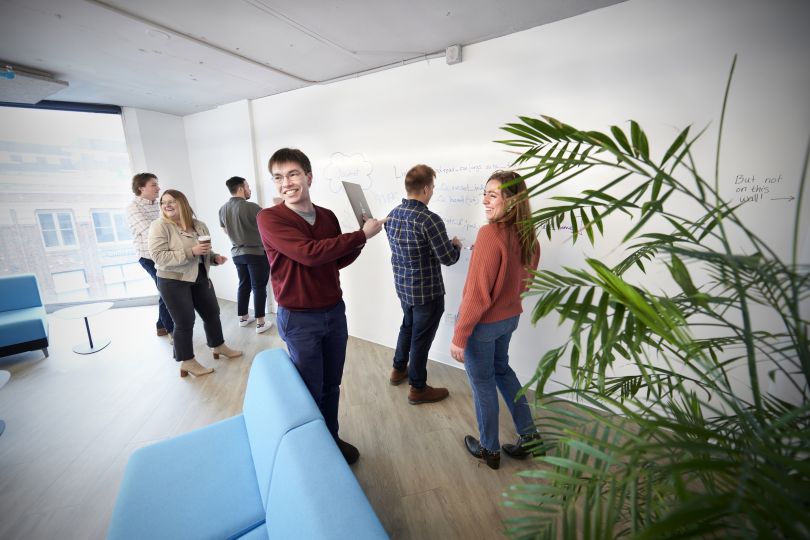Early in 2020, Meaghan Cassidy received a text message from an unlikely source.
The sender was a former colleague — a software engineer — who had left Cassidy’s company in search of a more exciting opportunity. They’d worked together on tangential teams, but the engineer had found a new role at Kensho.
“She reached out to tell me that Kensho was hiring product managers like me,” Cassidy said. “She explained that my scrappy yet professional style would be a good fit.”
Cassidy remembers reading the text and thinking about how nice it was. “I thought, ‘I’ll check this out tomorrow.’”
But Cassidy got a follow-up message the next morning: The engineer had already submitted a referral application on her behalf.
“The rest is history,” Cassidy said.
Kensho’s nimble, “scrappy-yet-professional” approach isn’t isolated to Cassidy’s recruitment process. Openness to change and a fast-paced engineering environment are driving their team as the company takes their suite of business applications to market.
Until recently, Kensho’s artificial intelligence tools were being used exclusively to support its parent company, S&P Global. But as the frontiers of data science and machine learning continue to expand, Kensho’s team saw new opportunities to solve interesting problems for other businesses. With a rich bank of data from within S&P Global, the company’s AI and machine learning algorithms offer rich, domain-specific insights to partners.
Team members of Kensho’s product-led, engineering-driven company shared an inside look at their work and culture as they build next-generation artificial intelligence business solutions for S&P Global and new partners worldwide.
Kensho’s products
- Scribe: Transcribe complex finance and business audio
- NERD: Identify entities in documents and link them to rich knowledge bases
- Extract: Standardize and extract tables and text from PDF documents
- Link: Organize entity data and ingest new datasets
- Datasets: Domain-specific training data for machine learning model training
How did you join Kensho?
Machine Learning Manager Yulia Shchadilova: I joined Kensho in June 2018, after working as a postdoc in theoretical quantum physics at Harvard. I kept hearing about the potential at Kensho, and I started looking into the company. Then all of the sudden, one of my colleagues approached me and said, “Kensho is looking for someone to do machine learning. Would you be interested?” They made a referral, and within a week, I had an interview.
I got an offer as soon as I stepped outside the office. I loved the interview process, and pretty quickly, I thought, “This is exciting. I want to join the company.” I started two weeks later.
“I thought, ‘This is exciting. I want to join the company.’ I started two weeks later.”
Business Development Manager Michael Hoffmann: I came to Kensho from the parent company, S&P Global, in June 2022. I had worked on the sales team in their commodity division, and I was actually looking to shift out of sales and go into academia in linguistics or philosophy of language. But then I realized that the Kensho focus on things like natural language processing was a compelling overlap with my interest — language dictates so much of our lives, and here was an opportunity to get involved with a deeper understanding of that without getting a PhD.
When I interviewed for the role, I really fell in love with everybody on the call and was so thoroughly impressed. To Yulia’s point, it was a quick process — suddenly I was working at Kensho.

What has the transition to go-to-market been like for the team?
Hoffmann: If you want to start working on something within S&P Global, the data is easy to access, and the engineers are ready to go. As you go to market, you start running into administrative barriers like legal constraints and security frameworks before we even start working with a client because we are processing a lot of data. There is a lot of trust-building upfront with the client when we start working externally.
Shchadilova: From a machine learning and engineering perspective, prior to going to market, we were mostly focused on research and development problems, and now we are much more focused on making our solutions more robust and reliable. When we build new models, we have new considerations for external needs, like data handling. I am definitely appreciative of this phase of Kensho when we have the opportunity to grow things from research and development into production client services.
Chief of Staff Meaghan Cassidy: When I joined, I was the product manager for building out our production infrastructure platform that would enable us to host our own APIs to bring our machine learning models to clients. S&P Global remains our first and best client, but as we built this infrastructure and ways to connect our products and services, it was clear that we had opportunities beyond S&P Global to offer our foundational AI capabilities to other business and finance clients. We knew other companies would have the same challenges in their business and financial workflows as S&P Global.
What has Kensho learned from how external clients use the products and services?
Hoffmann: Kensho Scribe, which is our most commercially successful product, is at its core a voice-to-text tool. In Scribe’s case, we used it internally to assist a human transcription team that would listen and transcribe earnings calls word-for-word. We saw in the market a potential client base in expert networks. A CEO might want to learn about the future of energy and bring in an energy expert for further insight on the matter. The expert network will transcribe that call and go on to sell it either as a direct service to that CEO or on a wider subscription basis with sensitive information redacted.
Even though the end deliverable is slightly different, those use cases are the same — transcribe something high value and sell it in a new format. But as we go to market, this is becoming increasingly different as we engage in other client segments, like call centers using transcripts for insights and analytics. I think we will continue to see widely varied use cases. We are only just scratching the surface of our capabilities.
Cassidy: Our competitive advantage is that we have a wealth of training data. Our solutions are purpose-built for business and finance, which means they would also work well for a conversation where we start using jargon. Scribe has more sensitivity to that than competitors who train their models on audiobooks and call center data. We get to test the waters of different markets, but we aren’t trying to build a one-size-fits-all audio transcription solution. We are building specifically for business and finance and have a lot more potential to unlock value combined with our other machine learning solutions.
“We build new puzzle pieces and fit them together.”
Shchadilova: I actually manage the machine learning engineers who work on Scribe, so I am supporting this work every day. We see how easily Scribe connects with our other products, like entity recognition tools and other in-house natural language processing models that can help solve client issues, and the opportunities continue to grow. We build new puzzle pieces and fit them together.

What does collaboration look like at Kensho?
Cassidy: I have so many thoughts about cross-functional communication and collaboration. It really does come down to talking. One of the things that we started doing this year in June and then again in October is something we call Collab Week. We invite everyone up to our Cambridge headquarters, and instead of doing a heavy agenda to support a conference-style meetup, we have team events and opportunities to build relationships.
Last week, I heard people coming out of a meeting and saying how energized they were by their pipeline review. It was because they had an opportunity to close client feedback loops, and saw how that feeds into product development and how engineers are thinking about better serving our users. Across the board, people really value coming together and having those other perspectives.
Natural language processing, security and compliance
What’s special about Kensho’s tech culture?
Hoffmann: I came from a background in large organizations, and what’s nice about Kensho is not only that feedback is truly heard, but also you can have ownership in the process of driving change. Rather than being siloed, we are able to react quickly to the market. The channels between teams are totally accessible. If you lean into the amorphous nature, you’re able to tap into a creative mindset.
“If you lean into the amorphous nature, you’re able to tap into a creative mindset.”
Shchadilova: I wanted to work in an organization that has a lot of smart people, but I also hoped to work in a collaborative and supportive environment. Academia can be extremely competitive, and when I joined Kensho, I found an environment where people could bring problems to each other and work together to solve it.
The pace of development here is amazing. People are able to turn around solutions quickly, which allows us to offer and receive immediate feedback. The combination of collaboration and a fast-paced environment are the best part of our tech culture.
Cassidy: My professional background is almost exclusive to startups. One of the most appealing things to me about Kensho is the fact that we are able to have this outsized impact within our parent organization. They give us the autonomy to move fast and be scrappy so we can make good decisions, and we take that responsibility to heart in terms of how we operate strategically as an organization.
When I joined, I was really intimidated by feeling like everyone had multiple PhDs, and I don’t. But I came to realize over time that I have a unique perspective to share and role to play. We are able to appreciate each other for the value we add to the organization. It takes all of us, together.








